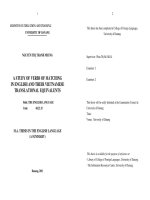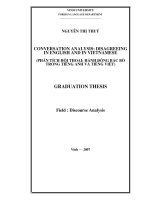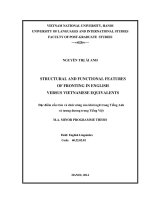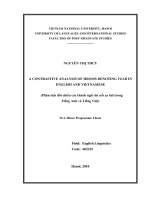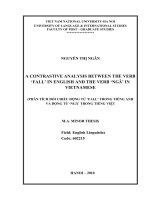Conversation analysis disagreeing in english and in vietnamese, phân tích hội thoại hành động bác bỏ trong tiếng anh và tiếng việt
Bạn đang xem bản rút gọn của tài liệu. Xem và tải ngay bản đầy đủ của tài liệu tại đây (440.92 KB, 75 trang )
VINH UNIVERSITY
FOREIGN LANGUAGE DEPARTMENT
Ngun thÞ thủ
CONVERSATION ANALYSIS: DISAGREEING
IN ENGLISH AND IN VIETNAMESE
(Phân tích hội thoại: Hành động bác bỏ
trong tiếng anh vµ tiÕng viƯt)
GRADUATION THESIS
Field : Discourse Analysis
Vinh – 2007
VINH UNIVERSITY
FOREIGN LANGUAGE DEPARTMENT
GRADUATION THESIS
CONVERSATION ANALYSIS: DISAGREEING
IN ENGLISH AND IN VIETNAMESE
(Phân tích hội thoại: Hành động bác bỏ
trong tiếng anh và tiếng việt)
Field : Discourse Analysis
Supervisor: M. A. Nguyễn Thị Têng
Student
: Ngun ThÞ Thủ
Class
: 44A1
Course
: 2003 - 2007
Vinh – 2007
ACKNOWLEDGEMENTS
I would like to express my deepest gratitude to my supervisor M. A. Ngun
ThÞ Têng, who introduced me to this topic – “Conversation Analysis: Disagreeing in
English and in Vietnamese” and helped me very much to do this study. If I had not
received her valuable guidance, comments, and criticism, I would not have completed
my thesis.
And I would also like to express my indebtedness to all my teachers at Foreign
Language Department, especially M. A. Phan Thị Vân Hơng, M. A. Nguyễn Thị
Bích HiÒn, Miss Mindy Schott, Miss Anne Edmunds and Miss Sandy Gannon for
their advice along with their great help with useful and up-to-date materials concerning
my field of study.
I also wish to thank the students at Foreign Language Department who were
willing to answer my questionnaires.
Finally, my sincere thanks go to my family and my friends who gave me the
best conditions to finish this thesis.
TABLE OF CONTENTS
ACKNOWLEDGEMENTS
TABLE OF CONTENTS
PART A - INTRODUCTION
1. Reasons for the study
2. Scopes of the study
3. Methods of the study
4. Aims of the study
5. Design of the study
PART B - DEVELOPMENT
CHAPTER 1 - THEORETICAL BACKGROUND
1.1. Functions of language
1.2. Conversation
1.2.1. Context
1.2.2. Exchanges and Turn-taking
1.3. Speech Act
1.4. Politeness and Strategies of Politeness
1.4.1. Politeness and Face
1.4.2. Strategies of Politeness
CHAPTER 2 - DISAGREEING IN ENGLISH AND VIETNAMESE
2.1. Disagreeing as a respond to a Speech Act
2.2. Directness - Indirectness – Politeness in disagreeing
2.3. Factors affecting directness and indirectness in disagreeing
2.4. Degrees of disagreement
2.5. Strategies of disagreeing
2.6. Similarities and Differences of disagreeing in English and Vietnamese
2.6.1. Similarities
2.6.2. Differences
2.6.2.1. Usage of personal pronouns
2.6.2.2. Usage of negative particles
2.6.2.3. Usage of idioms, proverbs, metaphor and folk verses
CHAPTER 3 - RESULTS, FINDINGS, AND SUGGESTIONS
3.1. Results
3.2. Major findings
3.4. Suggestive Activities
PART C - CONCLUSION
1. Concluding remarks
2. Suggestions for further study
REFERENCES
APPENDIX
1
1
2
2
2
2
3
3
3
5
5
7
9
10
10
10
12
12
13
14
16
17
22
22
24
24
26
30
32
32
33
36
41
41
41
43
44
PART A – INTRODUCTION
1. Reasons for the study
In the developing world, people need to contact and exchange information with
each other. In other words, people need to communicate. But how to communicate
appropriately is not easy, especially between people of different cultures, different
languages.
Moreover, when we take part in a conversation, it is common that we have
different ideas or even opposite ones. At that time, we want to express our
disagreement about that matter. This fact has raised one question: “How to express
one’s disagreement appropriately in order to keep the conversation going on?”. It is
considered an “art”! And this “art” is changeable in different languages.
For example: C and D have opposite ideas about Miss A.
C: Miss A is a wonderful girlfriend. (Questionnaire)
But D disagrees with C. In English, to express his disagreement, D can use the
particle of negation “NOT”, or “NO”, or both:
D: I don’t think so.
or
D: No, I don’t think so.
or simply D: No!
However, in Vietnamese, D can use various particles of negation like
không phải, chẳng phải, đâu (có) phải, có phải làđâu, có gì
mà là, etc.
D: Cô A không phải là một ngời bạn gái tuyệt vời.
or D: Cô A chẳng phải là một ngời bạn gái tuyệt vời.
or D: Cô A đâu phải là một ngời bạn gái tốt.
or D: Cô A có phải là ngời bạn gái tốt đâu.
or D: Cô A có gì mà là một ngời bạn gái tuyệt vời.
During the process of learning English with the study of Pragmatics, Discourse
Analysis and Background to English speaking countries, etc. we understand more
about the language, in general, and the strategies of disagreeing the English people
use, in particular. And knowing the similarities as well as the differences between
these strategies in English and in Vietnamese will help us to express our disagreement
appropriately whenever we communicate with the native or the foreign. That is why
we want to compare disagreeing in English and in Vietnamese. Besides, to help
Vietnamese students to master these strategies in daily conversations, we would like to
suggest some practising activities.
2. Scopes of the study
The study focuses on strategies of disagreeing in English and in Vietnamese
mainly in verbal communication.
Communication
Verbal communication
Intralanguage
Lexicon
Rules of grammar
Rules of phonetics
Rules of language use
and interaction skills
Paralanguage
Vocal characteristics
(Pitch, Volume, Rate)
Types of vocal quality
Vocal interferences
Silence, ….
3. Methods of the study
Quantities methods
Nonverbal communication
Extralanguage
Body language/Kinesics
Object language (clothing,
make-up, gifts,…)
Environmental language
(setting, time, colour,…)
Contrastive
Analysis of questionnaires
4. Aims of the study
We do the study with the following aims:
- To understand more about ways of disagreeing in English and in Vietnamese,
then to express our disagreement appropriately in any case.
- To compare and contrast those strategies of disagreeing in these two
languages in order to see their similarities and the differences under the influence of
the language and the culture.
5. Design of the study
The thesis is devided into three main parts:
Part A: Introduction
Part B: Development
Part C: Conclusion
PART B – DEVELOPMENT
CHAPTER 1 - THEORETICAL BACKGROUND
This chapter presents the theoretical background on which the study is based. It
includes four sections in which section 1.1 presents two main functions of language Transactional and Interpersonal languages; then conversations along with the role of
context, turn-taking and adjacency pairs in the interpretation of the utterance are
analysed in section 1.2. Finally, sections 1.3 and 1.4 view speech act, politeness and
strategies of politeness.
1.1. Functions of language
Generally, language is considered as a means of communication. In everyday
life, people use language for communication with various purposes: to exchange news,
to convey their feelings and thoughts to others, to define their relationship to each
other, to be a member of a social group, or to set up a certain type of speech event of
theirs, etc. In other words, language performs many functions in different situations.
However, “it would be unlikely that on any occasion a natural language utterance
would be used to fulfill one function to the exclusion of the others”. (Brown.G. and
Yule. G.)
Normally, listening to a conversation, we can know the communicative goals
or why and for what purpose the conversation is carried out. Moreover, from the
utterances in the conversation, we can realize the relationship between the participants
and their personal attitudes towards the mentioned matter. These are two main
functions of language. Brown and Yule call them Transactional and Interpersonal
languages. They propose that: “That function which language serves in the expression
of content, we will describe as transactional and that function involves in expressing
social relationship and personal attitude we will describe as interactional”.
(Discourse Analysis, Cambridge University Press, 1983: 1)
Another linguist, Bennet (1976: 5) also remarks that “it seems likely that
communication is primarily a matter of the speaker’s seeking either to inform a hearer
of something or to enjoy some action upon him.”
In the history of Discourse Analysis, many linguists have tried to call out the
main functions of language such as Buhler (1934): Representative/ Expressive,
Jakobson (1960): Referential/ Emotive, Halliday (1970b): Ideational/ Interpersonal,
Lyons (1977): Descriptive/ Social-expressive. But we would like to use the two terms
of Brown and George Yule: Transactional and Interpersonal in which the function
that language serves to express “content” is described as “transactional” and the
function language using to express “social relations” and “personal attitudes” is called
interactional.
a) Transactional language
According to Lyons (1977: 32), the main function of language is the
“international transmission of factual, or propositional information”.
As mentioned above, Bennett (1976: 5) also proposes that in a conversation,
the speaker wants either to inform the hearer something or to enjoin some action upon
him.
Clearly, transactional language is primarily message-oriented (i.e. the speaker
wants the hearer to get the information correctly). For example, a doctor tells a patient
how to take a medicine, a lecturer explains rules to a student, or a policeman gives
directions to a tourist, etc.
In transactional language, the speaker either gets some services/goods or offers
those to other people. If he/she receives directions to go to some where, or of doing
something, he/she gets services/goods. On the contrary, if he/she gives directions or
explanations, he/she offers services/goods to others.
Services/goods here are understood broadly as any act performed by the
utterance such as lending money, asking for advice, or passing a pot of salt, etc; not
only buying or selling something.
Moreover, transactional language is popular in written language such as
business writings like memoranda between two companies, or reports, or bills, etc.
Transactional language is formed by “turns”, “moves” and “acts” which will
be presented clearly later in section 2.1.2.
b) Interactional language
One of other important roles of language is to establish and maintain social
relationships. These relationships are established during the process of opening,
maintaining and closing conversations. In other words, interpersonal language is
associated with conversations.
Obviously, interpersonal language is relationship-oriented. To open a
conversation, the speaker tries to make a good impression on the hearer, then step by
step he/she talks about what he/she wants to mention to create a new relationship with
the interlocutor. It may be an apology, or a praise, or a love story, etc. And when the
conversation comes to an end, once again, the speaker attempts to make a good
impression to prepare for the next conversation in the future.
However, in different cultures, in daily conversations, people have different
conventional ways of using language to establish social relationships. For example:
In English, we can greet other people by saying “Hello/ Hi” or “Good
morning”, etc. Meanwhile, in Vietnamese, a question may become a greeting like
“Where are you going?”. Therefore, participants in a conversation need to share the
same knowledge background or a common point of view.
All the mentioned above features of Transactional language (TL) and
Interpersonal language (IL) are summarized in the following table:
THE COMPARING TABLE OF TRANSACTIONAL LANGUAGE
AND INTERACTIONAL LANGUAGE
Transactional language (T L)
- Message-oriented
- A prominent feature in written
language
- Formed by “turns”, “moves” and
“acts”
Interactional language (I L)
- Relationship-oriented
- Associated with conversations
- Formed by shared knowledge of the S and
H
NOTE: Although written language is mostly used for primarily transactional
purposes, some kinds of writtings are used to maintain social relationships like letters
to thank someone, or to express love for someone, etc.
1.2. Conversation
The word “conversation” includes two Latin roots: ‘con’ and ‘vers’in which
‘con’ means together, with; ‘vers’ means to turn about in a given direction.
There are many different definitions of a conversation but all of them define
that a conversation is an informal talk and in the conversation, there are at least two
people who exchange information to each other. Following are some definitions of a
conversation:
Dictionary of English language and culture of Longman (1992: 279) defines a
conversation as “an informal talk in which people exchange news, feelings, and
thoughts.”
“Conversations (and talk-exchanges in general) are usually structured
sequences of expressions by more than a single speaker. This structure is rarely
consciously apparent to speaker.” (Akmajian. A., Demers. R. A. & Harnish. R. M.,
1988: 415)
With these features, conversations play an important role in the development of
our society and in fact, conversations and written language are two main means of
communication of human beings. Therefore, Shotter (1993) states that “the basis of
social life is conversational”. Also, Neil Thompson (2003: 83) thinks that “a great deal
of meaning that we make of our lives come from our interactions with other people our conversations.”
When people interact with others, each side contributes to the process of
interpreting the situation, making sense of it and acting accordingly. In other words,
their conversation happens in a particular context which, in turn, decides what the
participants should do.
Conversations are a part of the communication. Communication is “a social
affair usually taking place within the context of a fairly well defined social situation.
In such a context we rely on one another to share our conception of what the situation
is”. (A. Akmajian, R. A. Demers & R. M. Harnish, 1998: 391)
1.2.1. Context
Context plays an important role in interpreting utterances. Many linguists have
taken the context into account.
a) What is the context?
Lancaster (1975: 56-57), an anthropologist who researches primate
communication, defines the communication context as follows:
“The context, then, of any communicative act includes a network of social
relations that have a considerable history behind them, all of which is relevant to the
message and how it is received and responded to.”
(Quoted by Akmajian. A., Demers. R. A. & Harnish. R. M., 1988: 37)
Meanwhile, Neil Thompson (2003: 83) tells that “The context of an interaction
sets the scene and shapes the meanings that will be attributed to what is said.”
Neil Thompson also reports that “According to Gumperz, contextualization
cues guide people’s expectations about how conversational and other exchanges
should develop appropriate modes of speaking the interpersonal relations involved,
and the speaking rights of those involved.”
In summary, context refers to the situation that gives rise to utterances and
within which the utterances are interpreted. There are two types of contexts: linguistic
and non-linguistic.
Linguistic context includes all linguistic elements in the utterance.
Non-linguistic or experiental context consists of the type of the communicative
event, the topic, the setting, etc - everything around the utterance.
b) Features of the context
Clearly, utterances in different contexts convey very different messages.
Firth emphasizes the role of context of situation for linguistic work with the
following catergories:
A. The relevant features of the participants: persons, personalities
(i) The verbal action of the participants
(ii) The non-verbal action of the participants
B. The relevant objects
C. The effect of the verbal action.
(Firth, 1957, quoted by Brown. G. & Yule.G., 1983: 37)
While Firth stresses three catergories of the context of situation, Hymes pays
attention to the dual roles of context in interpretation of the utterance. They are:
- Limiting the range of possible interpretations
- Supporting the intended interpretation
“The use of a linguistic form identifies a range of meanings. A context can support a
range of meanings. When a form is used in a context, it eliminates the meanings possible to
that context other than those the form can signal: the context eliminates from consideration
the meanings possible to the form other than those the context can support.”
(Hymes, 1962, quoted by G. Brown & G. Yule, 1983: 37-38)
Besides, Hymes proposes some elements of a context. Firstly, he defines eight
elements of the context as follows:
1. Addressor – The speaker or writer who produces the utterance.
2. Addressee (later audience) – The hearer or reader who is the recipient of the
utterance.
3. Topic – What is being talked about.
4. Setting – Where, when the event is situated.
5. Channel – How is the contact between the participants in the event is being
maintained - by speech, writing, singing, etc.
6. Code – What language, dialect or style of language is being used.
7. Message-form – What form is intended (chat, debate, sermon).
8. Event (The nature of the communicative event within which a genre may be
embedded).
Later, he proposes two more elements: Key (evaluation) and Purpose (what
did the participants intend should come about as a result of the communicative event).
Similarly, Lewis (1972) provides an index of coordinates which a hearer would
need to determine the truth of a sentence.
a) Possible-word coordinate: this is to account for states of affairs which
might be, or could be supposed to be or are.
b) Time-coordinate: to account for tensed sentences and adverbials like today
or next week.
c) Place-coordinate: to account for sentences like here it is.
d) Speaker-coordinate: to account for sentences which include first person
reference (I, me, we, our, etc.)
e) Audience-coordinate: to account for sentences including you, your,
yourself, etc.
f) Indicated object coordinate: to account for sentences containing
demonstrative phrases like this, those, etc.
g) Previous discourse co-ordinate: to account for sentences including phrases
like the latter, the aforementioned, etc.
h) Assigment co-ordinate: an infinite series of things (sets of things,
sequences of things…)
To summarize, the context is the situation in which the conversation is carried
out. It plays an important role in interpreting utterances of the conversation. Therefore,
to understand the meanings of an utterance, we have to put it in its context.
1.2.2. Exchanges and Turn-taking
a) Exchanges
In most of daily conversations there is a correspondence of one’s saying and
another’s reply or between the utterance function and the expected response:
A: Greeting
B: Greeting
A: Congratulation
B: Thanks
A: Apology
B: Acceptance/ Rejection
A: Inform
B: Acknowledgement
A: Leaving-taking
B: Leaving-taking
These constitute adjacency pairs which include two parts in which the first part
creates an expectation of the second part. Preference structure divides the second parts
into preferred and dispreferred parts.
First part
Assessment
Invitation
Offer
Proposal
Request
Second part
Preferred
Dispreferred
Agree
Disagree
Accept
Refuse
Accept
Decline
Agree
Disagree
Accept
Refuse
Table 2- The general patterns of preferred and dispreferred structures
(following Levinson 1983), (quoted by George Yule, 1996: 79)
While agreeing is a preferred response to a speech act of assessment or a
proposal, disagreeing is post-event and dispreferred response in which a different
opinion is pre-event act and initiation.
b) Turn-taking
In a two-people conversation, it is no need to determine who the speaker or the
hearer is because whenever there is a speaker, there must be a hearer or “Ngêi nãi ph¶i
cã ngêi nghe”. However, in a conversation of many people, allocution may aim at
only some certain participants or at all. The current speaker can use verbal or nonverbal signals to inform the next speaker. This creates a series of turn-taking: Speaker
– Hearer – Speaker – Hearer – Speaker – Hearer and so on. Normally, in a
conversation, turn-taking has the following order:
Opening
Taking a turn
(Holding a turn)
Passing a turn
Closing
We can also see three big moves in a conversation as follows:
Initiator
Follow-up
Ending
For example:
Initiator: Hello, John!
Follow-up: Hello, Peter. How are you?
I’m very well, thanks. And you?
Ending: I’m fine. Thanks.
(Streamline English – B. Hartley & P. Viney, Oxford University Presss, 2000: 7)
However, this order of turn-taking is changeable in a real-life conversation
because it is affected by a list of facts which is proposed by Sacks, Schegloff &
Jefferson (1978) as follows:
1. Overwhelmingly, one party talks at a time.
2. A change of speaker recurs.
3. Transitions between turns with no gap are common.
4. The order of turns is not fixed, but varies.
5. The length of turns is not fixed, but varies.
6. The length of the conversation is not specified in advance.
7. What parties say is not specified in advance.
8. Relative distribution of turns is not specified in advance.
9. The number of parties can vary.
10. Talk can be continuous or disco
